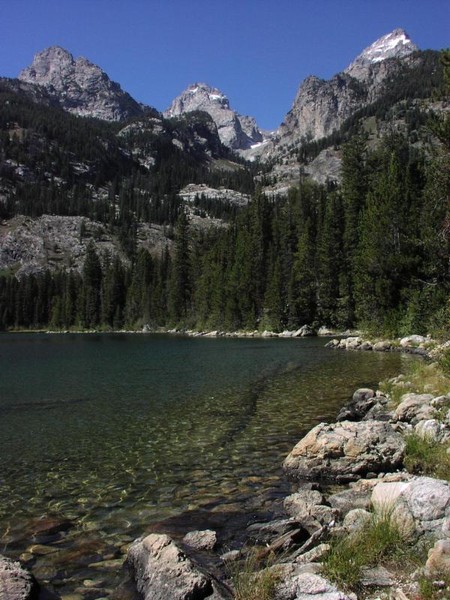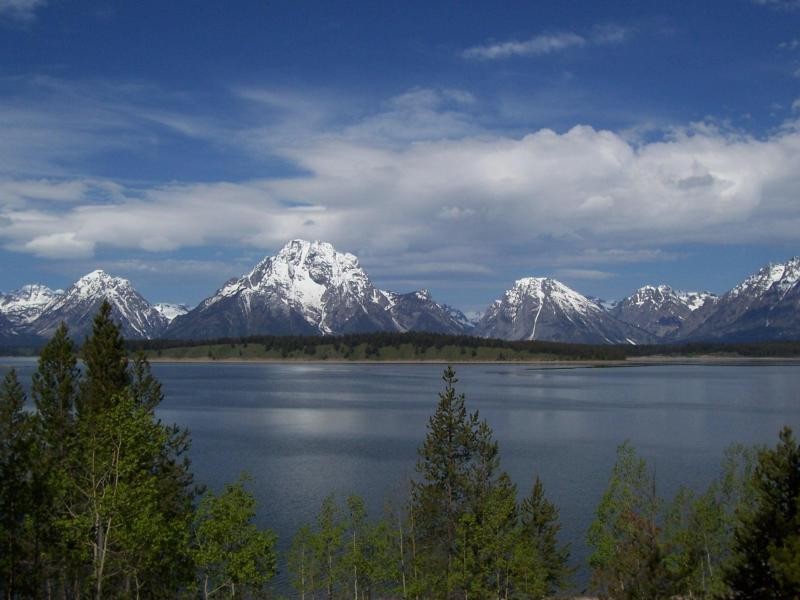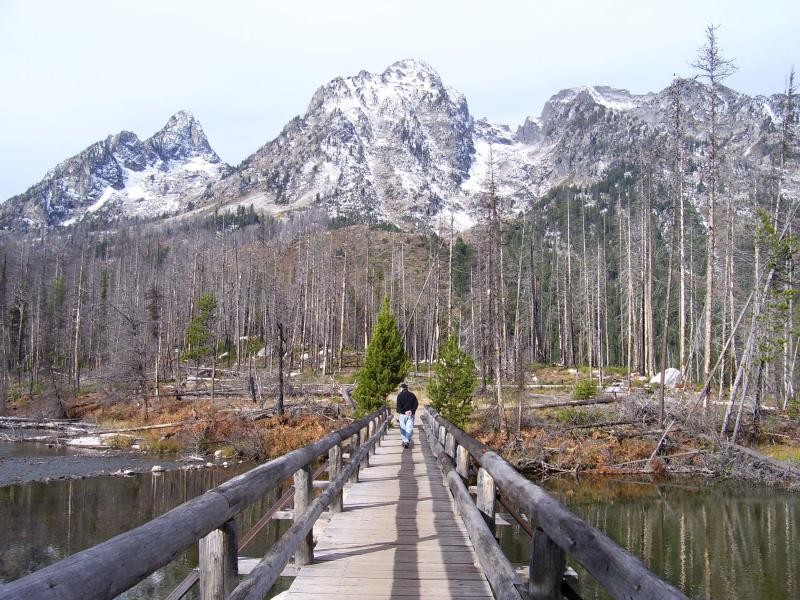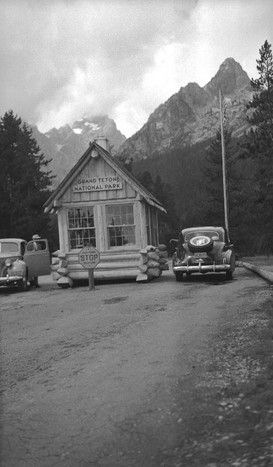Jenny Lake Visitors Center, Grand Teton National Park
Introduction
Text-to-speech Audio
Established on February 16, 1929, Grand Teton National Park is as grand as its northern neighbor, Yellowstone National Park. Originally built to preserve the area's wildlife and the Grand Teton mountain range, the national park has become a famous attraction in the Jackson Hole area. Guests come to appreciate the wildlife, hike, fish, bike, camp, and much more. The area is divided into different communities, each one full of unique creatures and tourist opportunities. There are several visitor centers in the park in addition to the one here at Jenny Lake.
Images
Death Canyon and creek

Native American Sheepeater family 1871

Bradley Lake

Jackson Lake

Hidden Falls

String Lake Bridge

1930 Park Entrance

Backstory and Context
Text-to-speech Audio
By the time Europeans arrived, the Grand Teton area had already be settled by Native American tribes, such as the Shoshone, Bannock, Blackfoot, Crow, Flathead, Gros Ventre, and Nez Perce. They hunted the native animals and gathered plants and minerals. The mountains held spiritual meaning for the American Indians. John Colter is the first known euro-American explorer to survey the area in the Lewis and Clark "Corps of Discovery" expedition.
In early 1800, fur trappers and "mountain men" came to the area in search of beaver. Beaver fur for top hats were extremely fashionable. Expert trapper David Edward Jackson based his entire fur trading operation off of Grand Teton's beaver population. Because of his outstanding work, the Jackson Hole area was nicknamed Davey Jackson's Hole in 1829. Over-trapping caused the beaver population to decrease. By 1840, fashions were being made with silk rather than beaver, and the trappers of Grand Teton became only legends.
In 1884, after the Homestead Act of 1862 encouraged western expansion, the first homesteaders arrived in the Jackson Hole area. Living conditions were not great. The soil was too rocky. Summers were too hot and winters were long and cold. However, the wealthy loved to visit the area to get the "cowboy" experience. The men were known as dudes and the women as dudenes. The locals realized there was more money to be made in lodging/feed/accommodating the rich easterners. Thus, "dude ranching" became more popular than cattle ranching or farming. With all the tourism, developments of cabins, gas stations, and racetracks start to crow the area. Businessmen, farmers, and other locals hold a meeting to discuss the town's expansion in 1923. They agree to preservation and conservation of the rest of the unsettled land.
John D. Rockefeller Jr. fell in love with the area in 1926. Within the next two decades, he purchased 35,000 acres of private land throughout the valley. The original park was created by Congress in 1929 to protect the Teton Mountain Range. Rockefeller dedicated his land to the federal government in 1949. The original park combined with FDR's national monument and Rockefeller's land to create what is the present day Grand Teton National Park.
More Americans had cars and were exploring after WWII. Grand Teton National Park accommodated the new travelers by opening up auto camps (small cabins with central parking area close to attractions). John D. Rcokefeller Jr. recognized the need for lodging and built an assortment of small cabins at Colter Bay, a lodge on the bluff overlooking Jackson Lake, and an extravagant lodge near Jenny Lake.
Today, the park is home to thousands of different plant and animal species. The land is divided into four major communities: alpine, forest, sagebrush flats, and wetlands. There are six different frogs species alone. A vast amount of lakes provides plenty of room for the large fish population. Fish are the primary food source for birds, mammals, and other fish at Grand Teton. The park provides the ideal ecosystem for birds such as the osprey and the bald eagle. Bird watching is a popular activity, but most wildlife watchers come to enjoy the mammals. The park is full of hoofed creatures such as moose, elk, deer, and bison. Predatory species such as mountain lions, grizzly bears, Black bears, and wolves can also be spotted, but are harder to find. Hikers and backpackers are relieved to hear there are no venomous snakes in the area. All snakes native to the area are harmless water snakes.
Apart from appreciating the wildlife, Grand Teton provides endless outdoor activities for guests. Backcountry camping is available for guests who want to spend multiple days hiking through the forest while sleeping in tents. Specific trails have been dedicated to those who wish to bike through the terrain. Hiking, fishing, climbing, and boating are limited to certain areas of the park. There is a ranger program for guests looking to get educated on the park's natural and cultural history. In the winter months, parts of the park are open for cross-country skiing and snowboarding.
In early 1800, fur trappers and "mountain men" came to the area in search of beaver. Beaver fur for top hats were extremely fashionable. Expert trapper David Edward Jackson based his entire fur trading operation off of Grand Teton's beaver population. Because of his outstanding work, the Jackson Hole area was nicknamed Davey Jackson's Hole in 1829. Over-trapping caused the beaver population to decrease. By 1840, fashions were being made with silk rather than beaver, and the trappers of Grand Teton became only legends.
In 1884, after the Homestead Act of 1862 encouraged western expansion, the first homesteaders arrived in the Jackson Hole area. Living conditions were not great. The soil was too rocky. Summers were too hot and winters were long and cold. However, the wealthy loved to visit the area to get the "cowboy" experience. The men were known as dudes and the women as dudenes. The locals realized there was more money to be made in lodging/feed/accommodating the rich easterners. Thus, "dude ranching" became more popular than cattle ranching or farming. With all the tourism, developments of cabins, gas stations, and racetracks start to crow the area. Businessmen, farmers, and other locals hold a meeting to discuss the town's expansion in 1923. They agree to preservation and conservation of the rest of the unsettled land.
John D. Rockefeller Jr. fell in love with the area in 1926. Within the next two decades, he purchased 35,000 acres of private land throughout the valley. The original park was created by Congress in 1929 to protect the Teton Mountain Range. Rockefeller dedicated his land to the federal government in 1949. The original park combined with FDR's national monument and Rockefeller's land to create what is the present day Grand Teton National Park.
More Americans had cars and were exploring after WWII. Grand Teton National Park accommodated the new travelers by opening up auto camps (small cabins with central parking area close to attractions). John D. Rcokefeller Jr. recognized the need for lodging and built an assortment of small cabins at Colter Bay, a lodge on the bluff overlooking Jackson Lake, and an extravagant lodge near Jenny Lake.
Today, the park is home to thousands of different plant and animal species. The land is divided into four major communities: alpine, forest, sagebrush flats, and wetlands. There are six different frogs species alone. A vast amount of lakes provides plenty of room for the large fish population. Fish are the primary food source for birds, mammals, and other fish at Grand Teton. The park provides the ideal ecosystem for birds such as the osprey and the bald eagle. Bird watching is a popular activity, but most wildlife watchers come to enjoy the mammals. The park is full of hoofed creatures such as moose, elk, deer, and bison. Predatory species such as mountain lions, grizzly bears, Black bears, and wolves can also be spotted, but are harder to find. Hikers and backpackers are relieved to hear there are no venomous snakes in the area. All snakes native to the area are harmless water snakes.
Apart from appreciating the wildlife, Grand Teton provides endless outdoor activities for guests. Backcountry camping is available for guests who want to spend multiple days hiking through the forest while sleeping in tents. Specific trails have been dedicated to those who wish to bike through the terrain. Hiking, fishing, climbing, and boating are limited to certain areas of the park. There is a ranger program for guests looking to get educated on the park's natural and cultural history. In the winter months, parts of the park are open for cross-country skiing and snowboarding.
Sources
"History and Culture." National Park Service. Accessed April 14, 2017. https://www.nps.gov/grte/learn/historyculture/cultural.htm.
